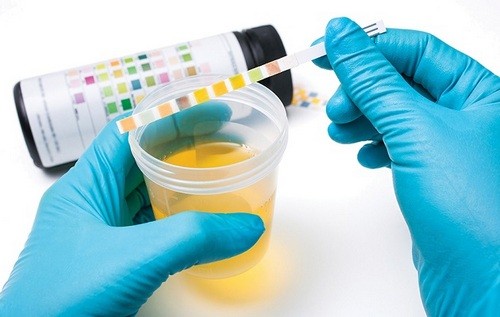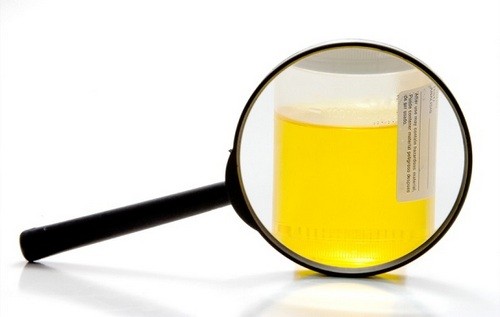By doing a urinalysis, you can determine the manifestation of any pathologies by various components.
So, red blood cells in the urine of a child (red blood cells) in the normal state will be absent or kept in a minimum amount not exceeding two units.
Changes in the composition of urine are called hematuria or erythrocyturia.
Standard metrics
A normal value is 2-4 units of red blood cells that are in the field of view during a microscopic examination of precipitated urine.
By the number of red blood cells, urine is characterized as micro- and macrohematuria. In the first case, the number of particles reaches up to 20, while the external indicators of urine do not change, and in the second – the number of red blood cells is huge, the urine becomes bright red or brown.
An elevated red blood cell count may indicate problems in the genitourinary system, gastrointestinal tract or lung diseases. Sufficient physical work can also demonstrate such results, but they are of a short-term nature and additional analysis refutes it.
According to the morphological classification, red blood cells are of the following types :
- Unchanged particles – the yellow discs in the form of a biconcave shape are visible in the microscope, which is evidence of blood entering the urine from the ureters, which means there are problems with the genitourinary system: urinary bladder, urethra, or excretory tract.
- Altered or leached – they are colorless, spherical or in the form of a disk, appear as a result of the release of hemoglobin protein from blood cells with prolonged contact with the acidic environment of urine.
This indicates that there is blood in the urine in the kidneys.
In order for the red blood cell norm in the urine of the child to not change, the diet should include products containing an alkaline environment and no cholesterol (boiled buckwheat, vegetables, nuts soaked in water, just clean water without gas), as well as reduce salt intake.
Causes of Hematuria
The causes of the appearance of red blood cells in the urine of a child are divided into two groups:
- Inflammatory processes in diseases associated with the urinary system.
- Diseases of other systems that provoke a kidney reaction to the production of red blood cells are reactive hematuria.
To correctly determine the cause of the increase in structural units in the urine, it is worth relying on such factors as:
- The presence in the sediment of urine of leukocytes, crystallized salt or casts of the renal tubules.
- General malaise of the child – complaints of lumbar pain, weakness, loss of appetite.
Given the data of the components, it is possible to accurately determine the initial cause associated with pyelonephritis or glomerulonephritis.
If red blood cells are found in the urine of the infant
Even with intrauterine development, the baby produces a greater number of red blood cells than the established norm, but after birth, normalization occurs very quickly.
Frequent catarrhal diseases of the respiratory tract can lead to particle growth, and vitamins are recommended for treatment. In infants, boys can be observed with the development and exposure of the glans penis, so it is worth visiting a specialist urologist.

How to prepare urine for analysis?
The results of tests to increase red blood cells in the urine of a child depend on preparatory measures before delivery.
It is very important to collect urine in the morning so that all indicators are objective.
Before the procedure, the genitals should be clean and washed.

Diseases leading to hematuria
A fairly large group of inflammatory diseases of an infectious and autoimmune nature or non-inflammatory diseases: the
kidneys and urinary system are distinguished :
- Glomerulonephritis is accompanied by a violation of the immune system of the glomeruli of the kidneys. In the sediment of children’s urine, altered red blood cells of more than 20 units are observed.
- Pyelonephritis is a disease in which a low number of red blood cells enters the urine along with the mucous membrane, but the number of leukocytes increases significantly.
- With cystitis, the mucous walls of the bladder are affected, and with urethritis, the urethra is affected.
- The formation of tumors in the tissues of the urinary system with rupture of blood vessels.
- Accumulation of stones in the urinary tract.
- Injury to internal organs.
Diseases provoked by other organs that cause intoxication of the whole body:
- Influenza, SARS.
- Intestinal bacterial infections, meningitis, and typhoid fever.
- Purulent diseases of tissues and bones (abscess, osteomyelitis).
- Sepsis.
Red blood cell treatment
If abnormalities are found, a set of measures should be taken: additional tests, ultrasound to accurately determine the cause.
Further recommended :
- adhere to a diet designed to normalize kidney function;
- taking anti-inflammatory and diuretic drugs, antibiotics;
- limiting the use of liquids and saline products.
Self-medication is not appropriate, the main thing is to identify the cause in time, make a diagnosis and prescribe the right drugs.



